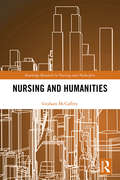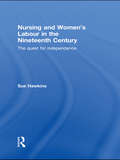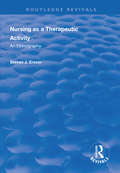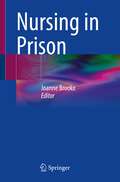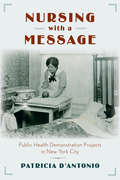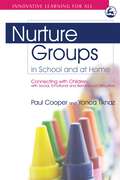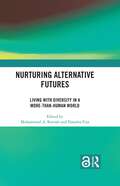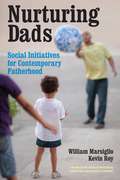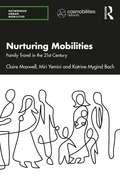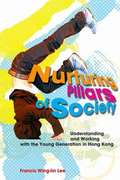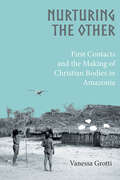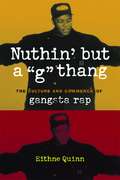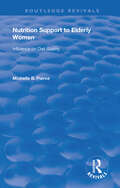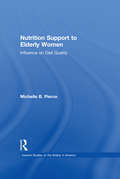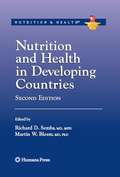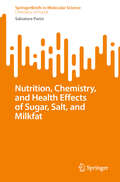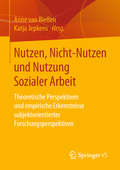- Table View
- List View
Nursing and Humanities (Routledge Research in Nursing and Midwifery)
by Graham McCaffreyThe humanities have long been recognized as having a place in nursing knowledge, and have been used in education, theory, and research by nurses. However, the place of humanities in nursing has always remained ambiguous. This book offers an in-depth exploration of the relationship between humanities and nursing. The book starts with a survey of the history of humanities in nursing, in comparison with medical humanities and in the context of the emergence of interdisciplinary health humanities. There is a description of applications of humanities within nursing. A central section offers an argument for placing the humanities firmly within a mixed model of nursing knowledge that is based upon embodied cognition. Final chapters explore these ideas through a series of essays on topics of humanities as a form of intervention, prose and poetry in relation to nursing, and applications of the Buddhist concept of interdependence. Nursing and Humanities is intended primarily for nurse academics and graduate students, who have an interest in nursing theory, applications of arts and humanities in education, and qualitative research approaches. It will also interest practicing nurses who are looking for an account of nursing that combines the technical and the human.
Nursing and Women's Labour in the Nineteenth Century: The Quest for Independence
by Sue HawkinsThis book presents a new examination of Victorian nurses which challenges commonly-held assumptions about their character and motivation. Nineteenth century nursing history has, until now, concentrated almost exclusively on nurse leaders, on the development of nursing as a profession and the politics surrounding registration. This emphasis on big themes, and reliance on the writings of nursing’s upper stratum, has resulted in nursing history being littered with stereotypes. This book is one of the first attempts to understand, in detail, the true nature of Victorian nursing at ground level. Uniquely, the study views nursing through an economic lens, as opposed to the more usual vocational focus. Nursing is placed in the wider context of women’s role in British society, and the changing prospects for female employment in the high Victorian period. Using St George’s Hospital, London as a case study, the book explores the evolution of nurse recruitment, training, conditions of employment and career development in the second half of the nineteenth century. Pioneering prosopographical techniques, which combined archival material with census data to create a database of named nurses, have enabled the generation – for the first time – of biographies of ordinary nurses. Sue Hawkins’ findings belie the picture of nursing as a profession dominated by middle class women. Nursing was a melting pot of social classes, with promotion and opportunity extended to all women on the basis of merit alone. This pioneering work will interest students and researchers in nursing history, the social and cultural history of Victorian England and women’s studies.
Nursing as a Therapeutic Activity: An Ethnography (Routledge Revivals)
by Steven J ErsserFirst published in 1997, this volume responds to the rapidly developing fields of nursing and health care fields and explores the meaning of nursing and the nurse-patient relationship through looking at the effects of a nurse’s personality, approach and understanding as being therapeutic for the patient’s experience. Steven J. Ersser explores areas including the concept of nursing as therapy, the presence of nurses and the effect of nursing on patient outcome. His book is part of a new series of monographs offering up-to-date reports of recently completed research projects in the fields of nursing and health care. The aim of the series is to report studies that have relevance to contemporary nursing and health care practice. It will include reports of research into aspects of clinical nursing care, management and education. This book, along with the series, will be of interest to all nurses and health care workers, researchers, managers and educators in the field.
Nursing in Hospice and Terminal Care: Research and Practice
by David M Dush Barbara PetrosinoA unique volume reflecting the state of the art in hospice nursing, Nursing in Hospice and Terminal Care addresses the special concerns of nurses--the primary professional caregivers in a hospice--in caring for terminally ill patients and in comforting their families. Experts highlight the major components of hospice nursing and address the enormous need for research that will help hospice nurses improve the quality of nursing care they are able to provide. Each valuable chapter is presented from a scientific base and offers practical applicability to nursing in various health care settings.
Nursing in Prison
by Joanne BrookeThis Textbook addresses a gap in the market, as currently there are no contemporary books exploring nursing within a prison setting. The main focus is the provision of healthcare in the Prison Service of England and Wales, although examples will also be drawn from the United States of America and Australia. Healthcare within prison settings has changed remarkably to address the needs of the changing prison populations. Thus, this text is clearly structured to support student nurses to understand the role of the nurse within prison and how the different specialities of nursing are applied in this unique setting. This textbook provides an overview of the context of prison, prisoners, and healthcare, as well as the experiences of nurse specialists who work in this field, including adult, mental health, and learning disability nurses across primary care, mental health services, substance misuse and end-of-life care. This volume is informative for both undergraduate student nurses and for qualified nurses and dispels many myths regarding working as a nurse in a prison. Each chapter is written by experts within the field, including nurses who have worked or still working within the prison setting. An important objective of this work is to inform student nurses of the possibility and opportunity of a nursing career within a prison setting.
Nursing the Nation: Building the Nurse Labor Force (Critical Issues in Health and Medicine)
by Jean C. WhelanModern health care cannot exist without professional nurses. Throughout the twentieth century, there was seldom a sustained period when the supply of nurses was equal to demand. Nursing the Nation offers a historical analysis of the relationship between the development of nurse employment arrangements with patients and institutions and the appearance of nurse shortages from 1890 to 1950. The response to nursing supply and demand problems by health care institutions and policy-making organizations failed to address nurse workforce issues adequately, and this failure resulted in, at times, profound and lengthy nurse shortages. Nurses also lost the ability to control their own destiny within health care institutions while nevertheless establishing themselves as the most critical part of health care provision today.
Nursing with a Message: Public Health Demonstration Projects in New York City
by Patricia D'AntonioMandated by the Affordable Care Act, public health demonstration projects have been touted as an innovative solution to the nation’s health care crisis. Yet, such projects actually have a long but little-known history, dating back to the 1920s. This groundbreaking new book reveals the key role that these local health programs—and the nurses who ran them—influenced how Americans perceived both their personal health choices and the well-being of their communities. Nursing with a Message transports readers to New York City in the 1920s and 1930s, charting the rise and fall of two community health centers, in the neighborhoods of East Harlem and Bellevue-Yorkville. Award-winning historian Patricia D’Antonio examines the day-to-day operations of these clinics, as well as the community outreach work done by nurses who visited schools, churches, and homes encouraging neighborhood residents to adopt healthier lifestyles, engage with preventive physical exams, and see to the health of their preschool children. As she reveals, these programs relied upon an often-contentious and fragile alliance between various healthcare providers, educators, social workers, and funding agencies, both public and private. Assessing both the successes and failures of these public health demonstration projects, D’Antonio also traces their legacy in shaping both the best and worst elements of today’s primary care system.
Nursing's Social Policy Statement: The Essence of the Profession
by American Nurses Association Staff"Last revised in 2003, this comprehensive revision to an enduring text updates its framework on the social roots and relationships of the nursing profession and nursing practice. An integrated discussion of its organizing topics - the social context of nursing, nursing's social contract, the definition of nursing, nursing's knowledge base, the scope of nursing practice, the standards of nursing practice, and the regulation of nursing - delineates the essential elements of the profession for nurses in any level or setting of practice and education."--Publisher's description.
Nursing, Policy and Politics in Twentieth-century Chile: Reforming Health, 1920s-1990s
by Ricardo A. Ayala Markus ThulinThis book offers the first in-depth account of healthcare policy in Chile across the twentieth century. It charts how nursing and nurses intersected with the political context of healthcare, with a focus on the country’s transition across welfare systems. Drawing on extensive archival research and interviews with nurses and governmental representatives, this book explores how the nursing profession implemented and challenged reform, while policies had an impact on nurses. It analyses nurses’ employment and mobility, and their lobbying through the press and through unions. The authors demonstrate that while Chilean health policy was influenced by US cultural politics, reform depended on the flexibility and willingness of nurses to carry through reforms. By examining the participation of the largest female professional group, the book offers new insights into the privatization of society on the pinnacle of industrial development and seeks to contribute to contemporary debates on Chile’s welfare system. It is a vital read for scholars researching the history of public health.
Nurture Groups in School and at Home: Connecting with Children with Social, Emotional and Behavioural Difficulties
by Paul Cooper Marion Bennathan Yonca Tiknaz Jim RoseThis book explores the ways in which pupils with social, emotional and behavioural difficulties can be effectively engaged in schooling - either in school or at home. It explains the social and emotional underpinnings of learning and presents practical strategies for aiding engagement. Nurture groups, originally devised and implemented in the 1970s, are specially designed classes that cater for pupils having difficulties in adjusting to the requirements of mainstream classrooms. Paul Cooper and Yonca Tiknaz present evidence of the success of nurture groups from the perspectives of the children participating in them, their parents and school staff members who manage nurture groups in schools, and examine what factors affect the success of the group. From this they draw key messages for effective practice, including the fundamental importance of recognising a child's emotional needs and meeting them, and the pivotal role of the relationship between the teaching staff co-ordinating the group. Nurture Groups in School and at Home will provide essential information and accessible advice for teaching professionals running nurture groups in schools and for parents and carers running them at home.
Nurturing Alternative Futures: Living with Diversity in a More-than-Human World
by Natasha Fijn Muhammad A. KaveshDeveloping upon emerging environmental humanities and multispecies anthropological theories, this book provides a fresh perspective on how we might rethink more-than-human relationality and why it is important to ‘nurture alternative futures’. It examines the life trajectories of people, animals, plants, and microbes, their lived experiences and constituted relationality, offering new ways to reinterpret and reimagine a multi-species future in the era of current planetary crises. The ethnographic case studies from around the world feature a combination of biological and cultural diversity with analyses that prioritize local and Indigenous modes of thinking. While engaging with Mongolian herders, Indigenous Yucatec Mayan, Congolese farmers, rural Pakistani donkey keepers, Australian heritage breed farmers, Croatian cheesemakers, Japanese oyster aquafarmers, Texan corn growers, Californian cannabis producers, or Hindu devotees to the Ganges River, the chapters offer a grounded anthropological understanding of imagining a future in relationality with other beings. The stories, lived experiences, and mutual worlding that this volume presents offer a portrayal of alternative forms of multispecies coexistence, rather than an anthropocentric future.
Nurturing Alternative Futures: Living with Diversity in a More-than-Human World
by Natasha Fijn Muhammad A. KaveshDeveloping upon emerging environmental humanities and multispecies anthropological theories, this book provides a fresh perspective on how we might rethink more-than-human relationality and why it is important to "nurture alternative futures". The diverse chapters examine the life trajectories of people, animals, plants, and microbes, their lived experiences and constituted relationality, offering new ways to reinterpret and reimagine a multi-species future in the current era of planetary crisis. The ethnographic case studies from around the world feature a combination of biological and cultural diversity with analyses that prioritize local and Indigenous modes of thinking. While engaging with Mongolian herders, Indigenous Yucatec Mayan, Congolese farmers, rural Pakistani donkey keepers, Australian heritage breed farmers, Croatian cheesemakers, Japanese oyster aquafarmers, Texan corn growers, Californian cannabis producers, or Hindu devotees to the Ganges River, the chapters offer a grounded anthropological understanding of imagining a future in relationality with other beings. The stories, lived experiences, and mutual worlding that this volume presents offer a portrayal of alternative forms of multispecies coexistence, rather than an anthropocentric future.
Nurturing Dads: Fatherhood Initiatives Beyond the Wallet
by Kevin Roy William MarsiglioAmerican fathers are a highly diverse group, but the breadwinning, live-in, biological dad prevails as the fatherhood ideal. Consequently, policymakers continue to emphasize marriage and residency over initiatives that might help foster healthy father-child relationships and creative co-parenting regardless of marital or residential status. In Nurturing Dads, William Marsiglio and Kevin Roy explore the ways new initiatives can address the social, cultural, and economic challenges men face in contemporary families and foster more meaningful engagement between many different kinds of fathers and their children. What makes a good father? The firsthand accounts in Nurturing Dads show that the answer to this question varies widely and in ways that counter the mainstream "provide and reside" model of fatherhood. Marsiglio and Roy document the personal experiences of more than 300 men from a wide range of socioeconomic backgrounds and diverse settings, including fathers-to-be, young adult fathers, middle-class dads, stepfathers, men with multiple children in separate families, and fathers in correctional facilities. They find that most dads express the desire to have strong, close relationships with their children and to develop the nurturing skills to maintain these bonds. But they also find that disadvantaged fathers, including young dads and those in constrained financial and personal circumstances, confront myriad structural obstacles, such as poverty, inadequate education, and poor job opportunities. Nurturing Dads asserts that society should help fathers become more committed and attentive caregivers and that federal and state agencies, work sites, grassroots advocacy groups, and the media all have roles to play. Recent efforts to introduce state-initiated paternity leave should be coupled with social programs that encourage fathers to develop unconditional commitments to children, to co-parent with mothers, to establish partnerships with their children's other caregivers, and to develop parenting skills and resources before becoming fathers via activities like volunteering and mentoring kids. Ultimately, Marsiglio and Roy argue, such combined strategies would not only change the policy landscape to promote engaged fathering but also change the cultural landscape to view nurturance as a fundamental aspect of good fathering. Care is a human experience—not just a woman's responsibility—and this core idea behind Nurturing Dads holds important implications for how society supports its families and defines manhood. The book promotes the progressive notion that fathers should provide more than financial support and, in the process, bring about a better start in life for their children. A Volume in the American Sociological Association's Rose Series in Sociology
Nurturing Mobilities: Family Travel in the 21st Century (Networked Urban Mobilities)
by Claire Maxwell Miri Yemini Katrine Mygind BachNurturing Mobilities employs new empirical material and an innovative theoretical framing to bring new clarity to why families travel today – and what happens when they do. The authors argue that an imperative to ‘think with mobility’ and to ‘aspire to be mobile’ shapes identities, futures, and family practices. Drawing on data that examines family travel practices – typically short-term trips – across the working-, middle-, and globally mobile middle-classes, Nurturing Mobilities describes how families travel, why they travel, and the role young family members play in curating family travel. Vitally, it examines the two biggest contemporary issues in global mobility: COVID-19, and climate change. How has COVID-19 changed travel motivations in a world beset by lockdowns and diminished finances? How are concerns around climate change, and engagements with global citizenship education, changing family travel practices? Nurturing Mobilities illuminates new ways in which social class divergence is forged through movements across borders. The authors’ theoretically inter-disciplinary approach delivers a full analysis of the apparently divergent processes that differentiate family travel along social class lines, yet also allow travel to play a core role in social mobility. This book is a vital resource for scholars and students studying mobility, globalisation, social class, and climate change engagement.
Nurturing Pillars of Society
by Francis Wing-lin LeeThe younger generation - those under the age of 25 - accounts for more than a quarter of
Nurturing the Other: First Contacts and the Making of Christian Bodies in Amazonia
by Vanessa GrottiCombining archival research, oral history and long-term ethnography, this book studies relations between Amerindians and outsiders, such as American missionaries, through a series of contact expeditions that led to the 'pacification' of three native Amazonian groups in Suriname and French Guiana. The author examines and contrasts Amerindian and non-Amerindian views on this process of social transformation through the lens of the body, notions of peacefulness and kinship, as well as native warfare and shamanism. The book addresses questions of change and continuity, and the little explored links between first contacts, capture and native conversion to Christianity in contemporary indigenous Amazonia.
Nuthin' but a "G" Thang: The Culture and Commerce of Gangsta Rap (Popular Cultures, Everyday Lives)
by Eithne QuinnIn the late 1980s, gangsta rap music emerged in urban America, giving voice to—and making money for—a social group widely considered to be in crisis: young, poor, black men. From its local origins, gangsta rap went on to flood the mainstream, generating enormous popularity and profits. Yet the highly charged lyrics, public battles, and hard, fast lifestyles that characterize the genre have incited the anger of many public figures and proponents of "family values." Constantly engaging questions of black identity and race relations, poverty and wealth, gangsta rap represents one of the most profound influences on pop culture in the last thirty years.Focusing on the artists Ice Cube, Dr. Dre, the Geto Boys, Snoop Dogg, and Tupac Shakur, Quinn explores the origins, development, and immense appeal of gangsta rap. Including detailed readings in urban geography, neoconservative politics, subcultural formations, black cultural debates, and music industry conditions, this book explains how and why this music genre emerged. In Nuthin'but a "G" Thang, Quinn argues that gangsta rap both reflected and reinforced the decline in black protest culture and the great rise in individualist and entrepreneurial thinking that took place in the U.S. after the 1970s. Uncovering gangsta rap's deep roots in black working-class expressive culture, she stresses the music's aesthetic pleasures and complexities that have often been ignored in critical accounts.
Nutrition Support to Elderly Women: Influence on Diet Quality
by Michell PierceFirst published in 2000. The growing elderly population suffers from a disproportionately large incidence of chronic and acute illnesses, as well as mental and physical disabilities. Supportive relationships can also impact positively on health and quality of life during the later years, in addition, social support is believed to exert a beneficial effect on food intake , thereby further increasing the overall influence of social support on health. However, little is known about the types and attributes of social relationships that influence food patterns. The objective of this study is to explore, in depth, specific aspects of social relationships and their association with dietary quality.
Nutrition Support to Elderly Women: Influence on Diet Quality (Garland Studies on the Elderly in America)
by Michell PierceFirst published in 2000. Routledge is an imprint of Taylor & Francis, an informa company.
Nutrition and Health in Developing Countries
by Richard David Semba Martin W. Bloem P. PiotThis updated and expanded book was written with the underlying conviction that global health and nutrition problems can only be solved through a firm understanding of the different levels of causality and the interactions between the various determinants. This volume provides policy makers, nutritionists, students, scientists, and professionals with the most recent and up-to-date knowledge regarding major health and nutritional problems in developing countries.
Nutrition, Chemistry, and Health Effects of Sugar, Salt, and Milkfat (SpringerBriefs in Molecular Science)
by Salvatore ParisiThis book covers sugar, salt and milk fat from a chemical perspective, and presents an overview of the role of these ingredients in our food, focusing on their flavors, satiety-inducing properties, nutritional impact, and health effects. The book begins with a chapter devoted to the chemical composition of these taste enhancers and satiety-inducing components, followed by a chapter that sheds light on the persuasive tactics employed by the food industry and their impact on consumer behavior, ultimately discussing the complex relationship between marketing strategies and public health. In Chapter 3, the author presents case studies and explores the nutritional requirements of these ingredients, while considering their physiological effects ad potential implications for human health. In Chapter 4, the author evaluates current consumption patterns and their implications, analyzing trends, policies, and opportunities to shape healthier dietary choices. The book closes with a chapter devoted to the effects of glucose, sodium and cholesterol deficiency, where the author discusses the consequences of imbalanced intake or deficiencies in these ingredients and outlines their impact on human health as well as evidence-based recommendations for keeping a balanced diet. Researchers, scholars, and students in the fields of food science, nutrition, chemistry will understand the appeal of this book.
Nutritionism: The Science and Politics of Dietary Advice (Arts and Traditions of the Table: Perspectives on Culinary History)
by Gyorgy ScrinisPopularized by Michael Pollan in his best-selling In Defense of Food, Gyorgy Scrinis's concept of nutritionism refers to the reductive understanding of nutrients as the key indicators of healthy food—an approach that has dominated nutrition science, dietary advice, and food marketing. Scrinis argues this ideology has narrowed and in some cases distorted our appreciation of food quality, such that even highly processed foods may be perceived as healthful depending on their content of "good" or "bad" nutrients. Investigating the butter versus margarine debate, the battle between low-fat, low-carb, and other weight-loss diets, and the food industry's strategic promotion of nutritionally enhanced foods, Scrinis reveals the scientific, social, and economic factors driving our modern fascination with nutrition.Scrinis develops an original framework and terminology for analyzing the characteristics and consequences of nutritionism since the late nineteenth century. He begins with the era of quantification, in which the idea of protective nutrients, caloric reductionism, and vitamins' curative effects took shape. He follows with the era of good and bad nutritionism, which set nutricentric dietary guidelines and defined the parameters of unhealthy nutrients; and concludes with our current era of functional nutritionism, in which the focus has shifted to targeted nutrients, superfoods, and optimal diets. Scrinis's research underscores the critical role of nutrition science and dietary advice in shaping our relationship to food and our bodies and in heightening our nutritional anxieties. He ultimately shows how nutritionism has aligned the demands and perceived needs of consumers with the commercial interests of food manufacturers and corporations. Scrinis also offers an alternative paradigm for assessing the healthfulness of foods—the food quality paradigm—that privileges food production and processing quality, cultural-traditional knowledge, and sensual-practical experience, and promotes less reductive forms of nutrition research and dietary advice.
Nuts and Bolts for the Social Sciences
by Jon ElsterThis 1989 book is intended as an introductory survey of the philosophy of the social sciences. It is essentially a work of exposition which offers a toolbox of mechanisms - nuts and bolts, cogs and wheels - that can be used to explain complex social phenomena. Within a brief compass, Jon Elster covers a vast range of topics. His point of departure is the conflict we all face between our desires and our opportunities. How can rational choice theory help us understand our motivation and behaviour? More significantly, what happens when the theory breaks down but we still cleave to a belief in the power of the rational? Elster describes the fascinating range of forms of irrationality - wishful thinking, the phenomenon of sour grapes, discounting the future in noncooperative behaviour. This is a remarkably lucid and comprehensive introduction to the social sciences for students of political science, philosophy, sociology and economics.
Nutzen, Nicht-Nutzen und Nutzung Sozialer Arbeit: Theoretische Perspektiven und empirische Erkenntnisse subjektorientierter Forschungsperspektiven
by Anne Van Rießen Katja JepkensMit theoretischen und empirischen Beiträgen zu subjektorientierten Forschungsperspektiven – sozialpädagogische Nutzer*innenforschung, sozialpolitische (Nicht-)Nutzungsforschung und Adressat*innenforschung – fokussiert dieses Buch die Frage, wie eine solche Forschungsperspektive an bestehende Fachdiskurse der Disziplin Sozialer Arbeit anknüpft und ob sich aus den empirischen Analysen Hinweise für die Profession(-alisierung) Sozialer Arbeit ergeben. Durch den Bezug auf die zentralen Kategorien (Nicht-)Nutzen und Nutzung gelangt in den Blick, wie eine Soziale Arbeit gestaltet sein kann, die sich an Partizipation und Nutzbarmachung orientiert und sich somit an emanzipatorischen Zielsetzungen wie Selbstbestimmung und Partizipation ausrichtet. Ferner wird auch deutlich, welche Grenzen und Barrieren verhindern, dass jene, die Angebote Sozialer Arbeit in Anspruch nehmen (müssen), überhaupt ‚etwas davon haben‘.
